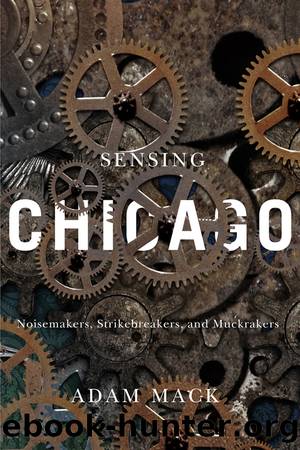Sensing Chicago by Adam Mack

Author:Adam Mack [Mack, Adam]
Language: eng
Format: epub
ISBN: 9780252080753
Barnesnoble:
Publisher: University of Illinois Press
Published: 2015-05-12T00:00:00+00:00
The Back of the Yards Jungle
Thirty years before Sinclair arrived in Chicago, the cityâs meatpacking industry undertook a major expansion around the Union Stockyards. Chicagoâs packers traditionally processed pork (salted or smoked) during the colder winter months. Chilling technology, especially the perfection of refrigerated railroad cars, eventually allowed them to operate year round; to reach the urban markets of the East; and to bring a wider range of livestock to buyers. Corporate mergers in the second half of the nineteenth century concentrated the industry, paving the way for the domination of the large packinghouses Sinclair targeted in his novel (Armour, Swift, and Morris). By 1900 the six largest packers slaughtered more than 95 percent of all livestock at the stockyards. The sheer number of animals killed each day attests to the size, complexity, and speed of the production system those corporations developed. The daily volume of the stockyards in 1900 reached seventy-five thousand cattle; eighty thousand sheep; and three hundred thousand hogs.38
Handling thousands of livestock units forced the packing companies to develop a production mechanism that ran continuously and to organize it down to the last detail: the disassembly line. Long before Henry Ford perfected assembly lines for automobiles, the meatpacking industry had developed what Barrett terms the âmost sophisticated production process in the United States before the turn of the century.â39 Disassembly took place on a factory floor with a seemingly incongruous organizational scheme. Within giant factory buildings, management controlled both the speed of the line and methods for the smallest tasks on it. The entire process relied on the hands of the individual workers who broke down the carcasses. One of Sinclairâs accomplishments in The Jungle is to capture the feverish sensory environment that workers on the line faced each day. His description of the gritty sights, sounds, smells, feel, and even tastes of the line is richest in the case of Jurgis himself, which we will soon consider in detail.40
The bulk of the work on the disassembly line required no special skills, so the packing companies hired corps of unskilled immigrant laborers.41 Back of the Yards housed a great deal of that workforce, growing by 75 percent in the first decade of the twentieth century, when Sinclair wrote The Jungle.42 Population growth also changed the ethnic makeup of Back of the Yards, transforming the neighborhood from an enclave of Irish and Germans to a diverse collection of immigrants that included Poles and Lithuanians.43 Sinclairâs decision to settle Jurgis and his family there reflected the diverse ethnic character of the neighborhood. The familyâs initial housing, a crammed tenement, also captured the density within residences.44 In 1910 researchers found that more than half of the people it surveyed in Back of the Yards slept in rooms that exceeded the minimum standard in local code, four hundred cubic feet per person.45
Crowding also inflamed the pollution of Back of the Yardsâ physical environment and bred disease. In The Jungle, Jurgis and his soon-to-be wife, Ona, are overwhelmed by the noxious sights and smells of garbage on their first tour of their neighborhood.
Download
This site does not store any files on its server. We only index and link to content provided by other sites. Please contact the content providers to delete copyright contents if any and email us, we'll remove relevant links or contents immediately.
A Cultural History of Work in the Age of Empire by Victoria E. Thompson (ed.)(289)
A Rome of One's Own by Emma Southon(273)
Executive Order No. 9066: The Terrible Injustice Of 1942 by Sollace Freeman(268)
The Evidence of Things Not Seen by James Baldwin(265)
The Explorers by Amanda Bellows(244)
Respectability and Reform by Tara M. McCarthy(239)
A Wider Type of Freedom: How Struggles for Racial Justice Liberate Everyone by Daniel Martinez HoSang(217)
The Grey Eagles of Chippewa Falls by John E. Kinville(189)
Liberty's Dawn: A People's History of the Industrial Revolution by Emma Griffin(188)
Rethinking White Societies in Southern Africa by Duncan Money(187)
Letters From London by Julian Barnes(182)
The Crosswinds of Freedom by James MacGregor Burns(179)
A Troublemaker May Surprise (The Troublemaker Series Book 2) by Genta Sebastian(171)
Evolution of Slavery Through the Ages: A Comprehensive World History of Slavery by PRESS VERITY(165)
Continental Strangers by Gemunden Gerd;(159)
A Teacher's Guide to Ladies of Liberty by Cokie Roberts Amy Jurskis(155)
The Slave Ship, Memory and the Origin of Modernity by Martyn Hudson(149)
Beware the Masher by Kerry Segrave(140)
Hunger Dark Pen by Dark Pen(137)
